A looper pedal is a device that records the desired portion of your track and loops it. The best looper pedal is one of the easiest ways to experiment with sound and combine musical phrases. The looping device can be an excellent tool for practice: to improve your sense of rhythm and time, to expand your creative boundaries, etc.
The working principle is quite simple. It functions similarly to a flash drive in that it allows you to record track fragments and replay them later. Some devices provide wider possibilities, like the opportunity to record and reproduce several fragments simultaneously or with a certain delay. It allows building up complex layers that make your sound fuller.
This type of the pedal l is not among the simplest types of effect pedals. However, it can be beneficial for anyone. There are no rules on how it must be used, the loop pedal is universal for multiple music genres.
There is no doubt that the looper effect is among the most widely used nowadays. Ed Sheeran frequently uses it with an acoustic guitar during live performances. Robert Fripp of King Crimson, U2’s David Evans, Queen’s guitarist Brian May, and other famous musicians are also known for using a looper pedal.
However, selecting the proper looping pedal might be a bit more difficult than you may be expecting. After all, no matter what, you will obviously need the product of a great quality able to fatten up your sound. Our article is aimed to help you choose the best looper pedal among the wide array of various models offered by today’s market. We present our top 8 picks of various models, from the simplest one-knob units to large and complex devices. Plus, our buyer’s guide will supply you with some important information that you need to consider when picking the most suitable unit.
Looper Pedal Reviews
BOSS RC-1
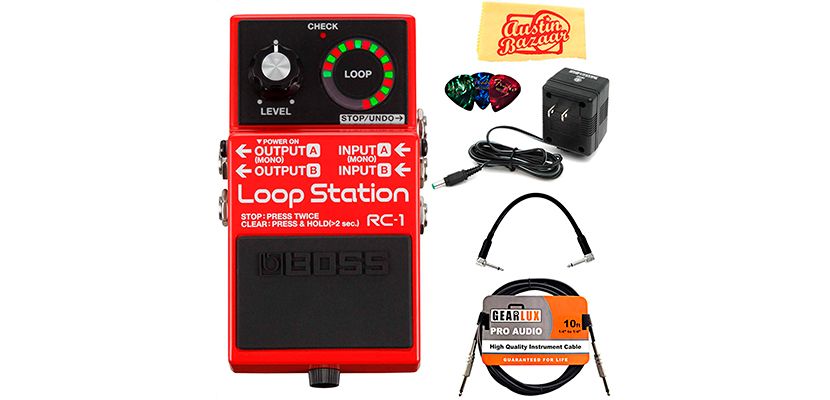
This entry-level Boss loop pedal is simple and has a user-friendly interface. One multifunctional control is responsible for recording, overdub, and playing. The knob on the front part of the RC-1 controls the level of volume. The round loop indicator which contains 24-segment LED shows the current loop mode and lengths. The maximum recording duration of the pedal is 12 minutes. The last recorded fragment will be saved in the pedal’s memory even after the device has been turned off.
Supplied with two inputs and outputs, the RC-1 provides a high-quality sound and the ability to be used with stereo effects and amplifiers. Moreover, you can also connect a stereo instrument to the pedal (such as a synthesizer, for example). It can be powered by both a 9V battery and adapter. Furthermore, the power supply is included with the kit, allowing you to put the pedal in and start playing straight away.
Pros
- The pedal comes bundled with Austin Bazaar polishing cloth.
- With 8 x 5.5 x 3.5 inches of size dimensions, the RC-1 is one of the most compact models.
- The RC-1 provides the ability to be used with external footswitches.
Cons
- The pedal doesn’t have USB for downloading the audio.
- For some reason, one of the loops didn’t record.
Video BOSS RC-1
BOSS RC-3
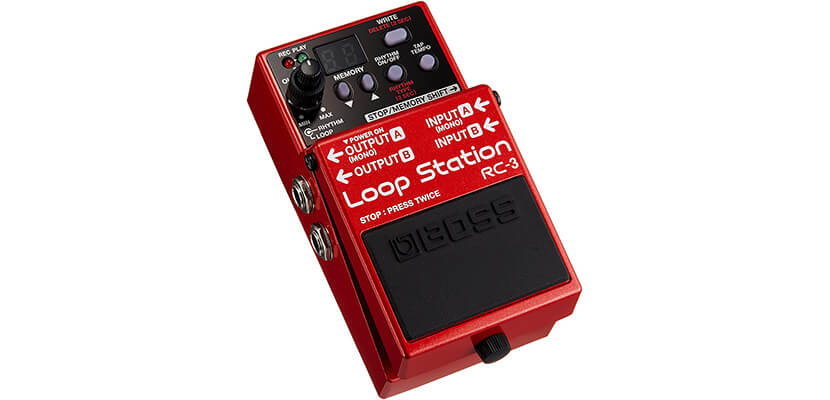
The Boss RC-3 has approximately 3 hours of stereo recording and up to 99 loops. There is also the ability to connect the pedal via USB and transfer the recorded samples to the computer and vice versa (the RC-3 accepts files up to 1.7GB in size). The front panel contains the indicators of the record/play mode.
This loop pedal has a simple built-in drum machine with 10 patterns (Rock, Pop, Funk, etc.). A special knob allows adjusting the volume of the rhythm, and there is also the ability to set a Tap Tempo. The pedal also analyzes and determines the pace of the recorded segment. This way, the Tap Tempo indicator will be blinking to the beat of your recording so it’s not so easy to get confused.
The BOSS RC-3 starts recording automatically as soon as its input receives the signal. Plus, when you save a track fragment, the rhythm type and time signature will be saved as well.
It has two inputs and two outputs which allow connecting the device to guitars, synthesizer, effects processor, etc. With 12.9 x 7.3 x 5.9 inches of size, the RC-3 may seem not very compact for someone, but it’s quite light since weights only 1 pound.
Pros
- You can connect FS-5U or FS-6 footswitches to the RC-3.
- This model has an AUX input so you can record samples with your phone, mp3 player, etc.
Cons
- The pedal goes without a 9V charger.
- It is possible that some noise will be introduced into the signal chain.
Video BOSS RC-3
Digitech TRIOPLUS
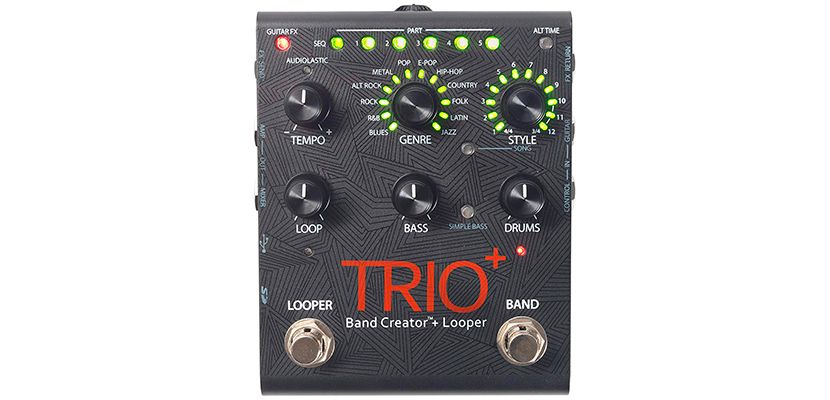
This triple effects loop pedal is easily operated thanks to its automatic function to generate bass and drum parts that match your song by reading your guitar signal in real-time. The pedal includes 12 most popular music genres and 12 styles which are controlled by a separate knob.
The pedal provides 230 seconds of maximum recording time per one song part. Except for the looping effect, this multifunctional pedal also offers Band Creator Bass and Drum tracks. The adjustable tempo has an Audiolastic time stretching and ensures a quick selection of an alternate time interpretation.
The Digitech looper pedal is capable of memorizing up to 5 sections of the composition. You can switch between them during your performance using the DigiTech FS3X footswitch.
Loops may be stored on the pedal’s included 8GB microSD card. The Librarian Manager freeware is provided for further work with your recordings. Both versions for Windows and Mac can be downloaded from the official website.
Pros
- The kit includes the DC power supply.
- The pedal is great for quick drum and bass accompany for a single person band thanks to its multifunctionality.
- The pedal sounds well with both the PA system and headphones.
Cons
- The absence of a time code makes synchronizing sections quite challenging.
- With 17.2 x 9.2 x 6.5 inches of size dimensions, the pedal takes a lot of space on the pedalboard.
Video Digitech TRIOPLUS
TC Electronics Ditto Looper
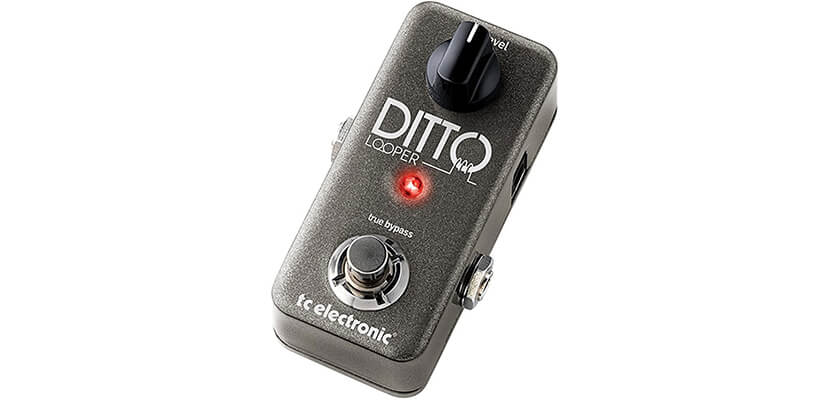
This bass looping pedal from TC Electronics is mainly designed to provide simplicity and has only the essential looping features. It’s supplied with one multifunctional control knob (Record, Undo/Redo, Stop and Erase), true bypass for optimum clarity, and only 5 minutes of looping time. The indicator on the front of the pedal comes red during recording and green during playing a loop. One audio input and output are available on the pedal.
It’s tiny (10 x 8 x 4 inches of size dimensions) so won’t take much space on any pedalboard. It’s also very light, weighing less than a pound.
The TC Electronics Ditto looping pedal provides an unlimited number of overdubs. This is not very handy for live performances but definitely useful for rehearsals. Because the pedal is primarily for personal usage, it lacks quantization and a metronome.
Pros
- The pedal has a USB mini-B type connector.
- Analog-Dry-Through keeps the total integrity of the analog dry signal path.
- The 24-bit uncompressed audio contributes to high-quality sound.
- Even when the device is turned off, the loops remain stored in the internal memory.
Cons
- The pedal requires the usage of power supply with isolated outputs so it didn’t produce the hum.
Video TC Electronics Ditto Looper
Nux Loop Core
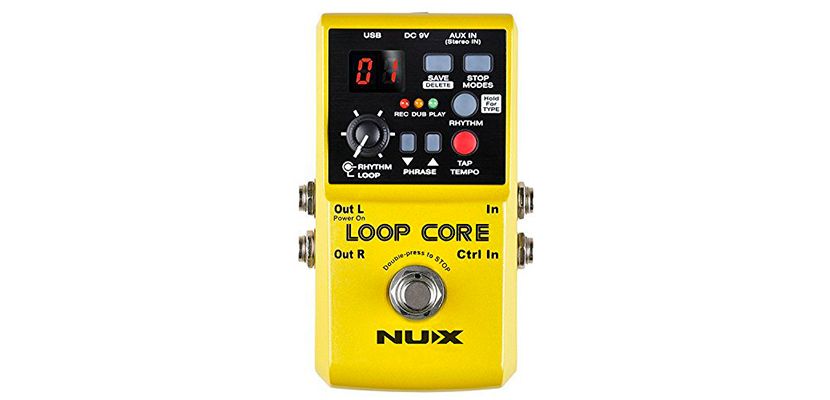
This looping pedal has a recording duration of 6 hours and 99 slots in mono and stereo. To transfer from the looper to PC, the device is supplied with a USB port.
The inbuilt drum machine includes 40 patterns with Tap Tempo. You can also connect the microphone through the Aux-in and record yourself singing. Plus, you can tune the playback tempo of the already recorded fragments without changing the key. The switching between phrases carries out without any latency.
Despite having such a big amount of options, it has quite modest size dimensions of 2.5 x 4.7 x 1.4 inches and weighs less than a pound (9.3 ounces). The enormous amount of options on this tiny device, however, may make it difficult to utilize.
Pros
- 2GB of internal memory is sufficient for most applications.
- The Nux Loop Core comes in a durable aluminum alloy housing.
- The pedal can be powered by both batteries and an AC adaptor.
Cons
- The round-style button which stops the recording is difficult to hit twice quickly.
- The drum tracks don’t sound natural.
Video Nux Loop Core
Electro Harmonix Canyon
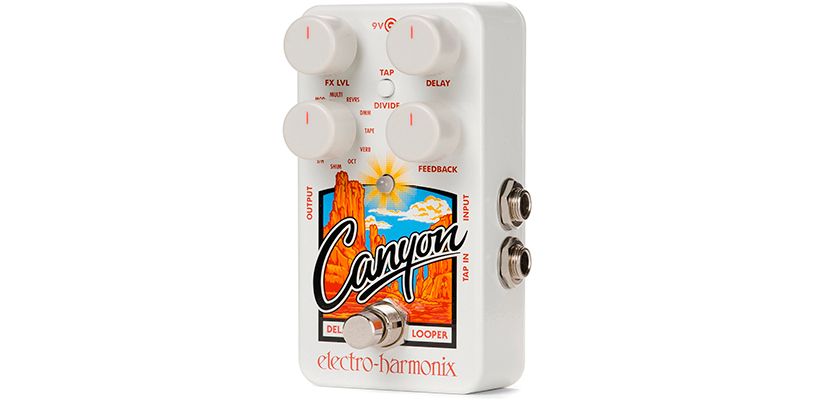
The Electro Harmonix combines delay and looper pedal, has 10 delay effects controlled by a separate effect selector and provides 62 seconds of loop length. It will enough for rehearsals and songwriting, but it will be insufficient for perfomance on a stage. Additionally, the EHX looper pedal includes the reverb which can be used for more spacious sounding. Despite such multifunctionality, the pedal itself is so tiny (7 x 6 x 2.6 inches) that can even be the smallest on your board and doesn’t even weigh a pound.
There are also the FX Level, Delay, and Feedback control knobs. The Tap/Divide button is responsible for the rhythmic subdivisions that you will get access to by tapping out the tempo. It also allows changing functions of the control knobs for deeper editing parameters, like modulation of the signal, tape age, etc.
Pros
- The pedal enables you to achieve 1950s slap-back tones.
- It comes with an AC/DC adaptor.
Cons
- The sound is not in stereo.
- It misses some parts of the loop.
Video Electro Harmonix Canyon
Electro-Harmonix 720
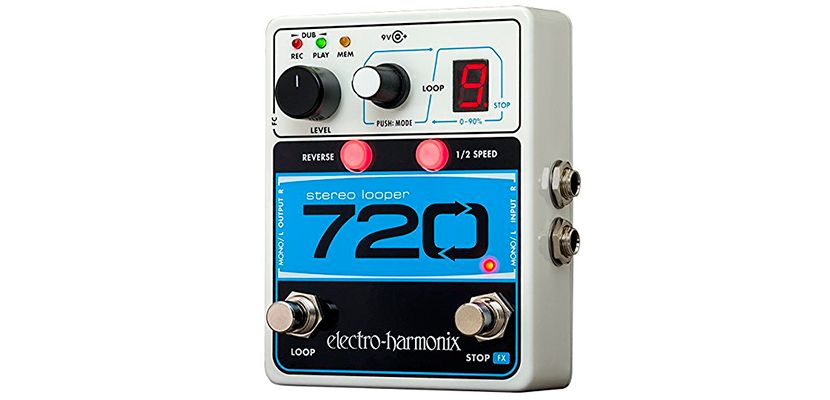
This guitar looper from Electro-Harmonix provides 12 minutes of maximum recording time and contains 10 loops. One multifunctional button allows controlling Stop, Undo-Redo, Reverse, and Half-speed effects. The stereo input and output ensure better stability.
This device allows you to record two different instruments at the same time. Plus, its footswitches are completely silent. The foot controller input allows using 3-button foot controllers. It also allows access to instant Undo-Redo.
The unit comes with an AC Adapter but can also be powered by a 9V battery. However, it isn’t included in the kit. With 7.2 x 6.2 x 3.2 inches of size dimensions, the pedal is quite compact.
Pros
- This model provides unlimited overdubbing.
- The pedal has a simple control interface.
- It ensures an uncompressed sound.
Cons
- The pedal introduces some hiss and noise into the sound chain.
- There is no sync or tap tempo.
Video Electro-Harmonix 720
TC Helicon Ditto Mic Looper
![]()
This bass looping pedal from TC Electronics is mainly designed to provide simplicity and has only the essential looping features. It’s supplied with one multifunctional control knob (Record, Undo/Redo, Stop and Erase), true bypass for optimum clarity, and only 5 minutes of looping time. The indicator on the front of the pedal comes red during recording and green during playing a loop. The pedal has one audio input and one audio output.
It’s tiny (10 x 8 x 4 inches of size dimensions) so won’t take much space on any pedalboard. It’s also very lightweight, weighing less than a pound.
The TC Electronics Ditto looping pedal provides an unlimited number of overdubs. This is not very handy for live performances but definitely useful for rehearsals. The pedal doesn’t have quantization or metronome since it’s designed mainly for individual use.
Pros
- The pedal is equipped with a USB mini-B connector.
- Analog-Dry-Through keeps the total integrity of the analog dry signal path.
- The 24-bit uncompressed audio contributes to high-quality sound.
- The loops are saved in the internal memory even when you turn the device off.
Cons
- The pedal requires the usage of power supply with isolated outputs so it didn’t produce the hum.
Video TC Helicon Ditto Mic Looper
Buyer’s Guide
How to Choose a Looper Pedal?
Some models are versatile for any usage, and others appeal to a certain kind of musician.
One of the basic things you should look for is the number of footswitches. They are responsible for how much control you will have over your pedal and what you will be able to do with it. Some may just have a single multipurpose footswitch that controls record, play, pause, overdub, and erase. The others have two and more footswitches, therefore give more control, but they are more complicated to use.
Some loop pedals give the opportunity of connecting the external footswitches in addition to the existing ones. This way, you can update your unit when you need some wider possibilities instead of buying the new one.
The loop pedals may have mono and stereo outputs. Mono is good for jamming, but if you want to record your loops in stereo, you will need a model with stereo output or both types of outputs.
The additional features are also important. Some pedals are supplied with inbuilt loop effects, like reverse (the possibility to play the recorded loops backward), half-speed (the loop will sound an octave lower), etc. The usage of such effects doesn’t affect your regular tone and can be helpful for songwriting.
Some models are also compatible with microphones and MIDI controllers. However, if you are going to use your looper pedal only with a guitar, you don’t need a device that gives such opportunities.
Budget
Before you begin selecting the most appropriate model, you need to figure out how much money you will need to spend on purchasing the desired item. The modern looper pedals will not limit your budget: on the average, there are the devices in the price range from 50 to 600 dollars.
You can easily get seduced by all those features that the advanced loopers are able to offer but, in fact, not every musician needs them. Don’t choose the pedal just because it’s offered by a sought-after brand or is advertised by a famous musician. Especially if you are a beginner. Even if such a device guarantees a decent quality, you may simply not be able to cope with it due to a lack of experience. Consider only the functions you are able to work with.
Some models of looper pedals allow adding some external effects to the original recording, adjust pitch and speed, etc. You can also choose from the floorboard and compact looper pedals. The first ones are obviously more costly since they have an impressively wide functionality. However, there is no reason to go for a floorboard model if you don’t consider the looper effect as one of the most important ones for your playing or singing experience. The compact models may be supplied with only one knob and be small enough to fit in your palm.
How Do You Plan to Use The Pedal?
Figuring out how do you plan to use the loop pedal is the main criterion for selecting the right unit. So if you already know how you want to use the pedal, it will significantly simplify your choice. The looping pedals differ in a significant way in their features and options. Some of them are designed for creating only the simplest loops, and the others allow adding some gimmick sound effects. This way, if you need the pedal to simply loop one of your guitar sections than you don’t need a model with lots of knobs and levers. A cheap looper pedal without bells and whistles will cope great with this job.
However, if you need more than one type of loops and require a superior recording quality, it will be necessary to put some money into a more complex looping unit that will cover your requirements.
The looper pedal is a universal device that has various applications. It can be used with electronic instruments such as electric and bass guitars, synthesizer, electric piano, etc. It also can be used to emphasize the vocal parts by making them more voluminous. However, its main purpose is to give a musician the opportunity to play or sing several parties simultaneously.
Besides, the this pedal is relevant mostly during rehearsals when creating music and recording tracks to replace several musicians with one.
What Length Of Loops Do You Need?
The length of the loop is responsible for your pedal possibilities: the longer the loop is, the more options to modify the sound you get. The loop length depends on the pedal memory capacity and on its ability to expand the memory. The simple models have minutes of recording capacity. The more complex pedals may have several hours of recording memory. Except for the built-in memory, the advanced models have an SD card slot that allows increasing the recording length.
Deciding what length of loops do you need, keep in mind that clean recording quality will require more memory. The SD card gives even more opportunities to record loops in a CD quality. There are also looping pedals that have enough memory capacity to give the possibility to save your loops.

Hi everyone! I’m Thomas Moody, also known as Guitarzan.
